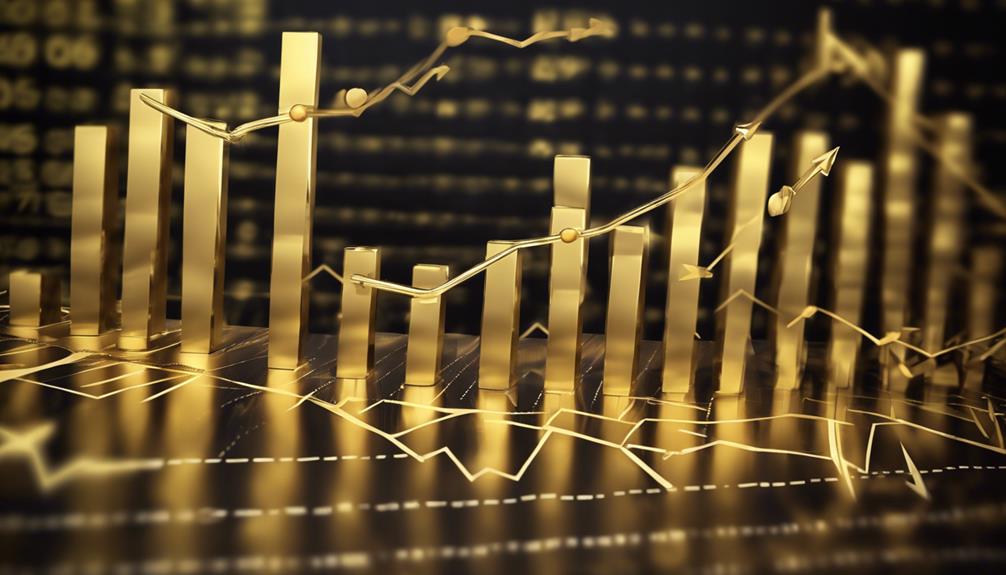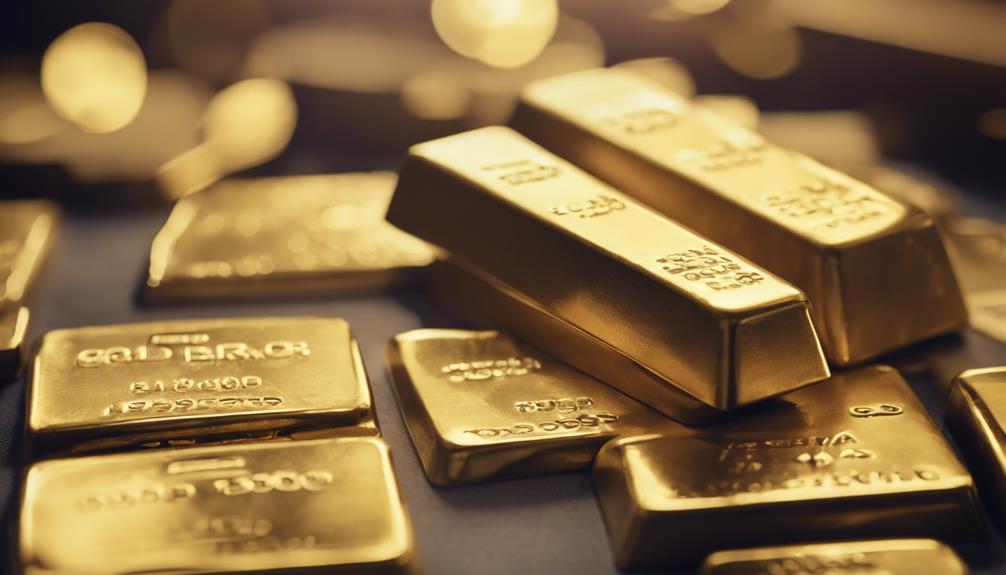Gold prices are affected by a variety of factors such as inflation, supply dynamics, interest rates, central bank policies, geopolitical tensions, US dollar strength, investment demand, cultural preferences, and market sentiment. The relationship with inflation can be complex, sometimes acting as a hedge. Central banks, mining output, and recycling rates have a significant impact on gold prices. Interest rates, particularly decisions by the Federal Reserve, influence the value of gold. Geopolitical tensions and the strength of the US dollar also play important roles. Moreover, investment demand, cultural significance, and market sentiment all contribute to the intricate dynamics that impact gold prices. Having an understanding of these factors can provide insight into movements in gold prices.
Key Takeaways
- Gold prices are influenced by inflation, but the relationship is nuanced.
- Central bank decisions, interest rates, and geopolitical tensions impact gold prices.
- Market sentiment, investment demand, and cultural preferences play key roles in determining gold prices.
- US dollar strength, supply factors, and investment shifts affect the value of gold.
- Speculative trading, media coverage, and economic conditions drive short-term fluctuations in gold prices.
Correlation to Inflation
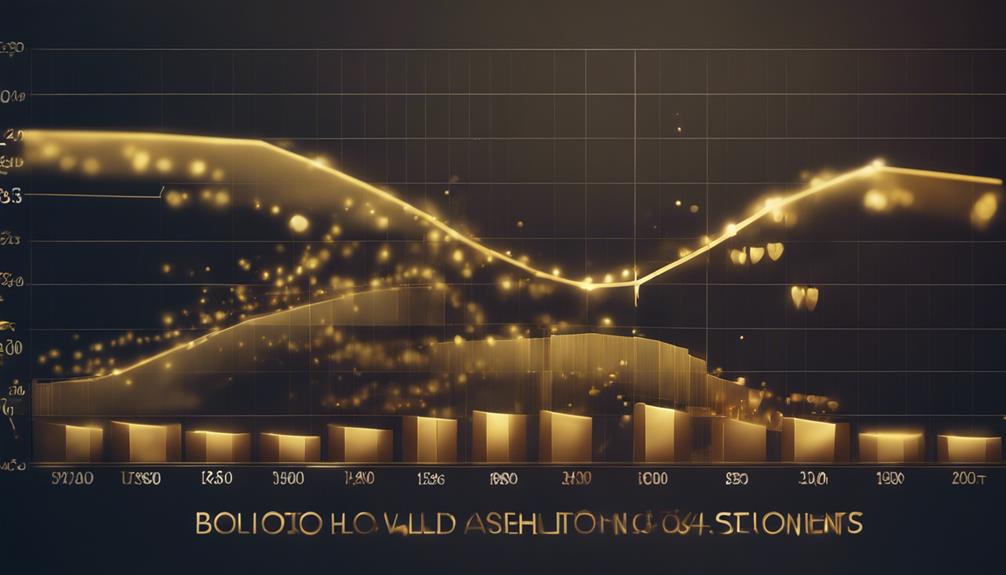
Gold prices exhibit a nuanced relationship with inflation, as evidenced by their behavior in various economic conditions. While there is a common belief that gold serves as a hedge against inflation, the correlation is not always straightforward. In 2022, for instance, gold prices declined despite a 7% inflation rate, highlighting the complex behavior of this precious metal. Economists Erb and Harvey have also found a weak correlation between gold prices and inflation, suggesting that other factors, such as market perception, play a significant role in determining gold's value.
Although gold is often viewed as a risk on/risk off asset, it may not consistently act as a traditional hedge against inflation. Extreme market turmoil can lead to declines in gold prices, further showcasing the intricate nature of gold's behavior in relation to inflation. As a result, while there is a direct inflation correlation at times, the overall relationship between gold prices and inflation is influenced by multiple variables, making it a topic of continued study and analysis in the financial world.
Supply Factors
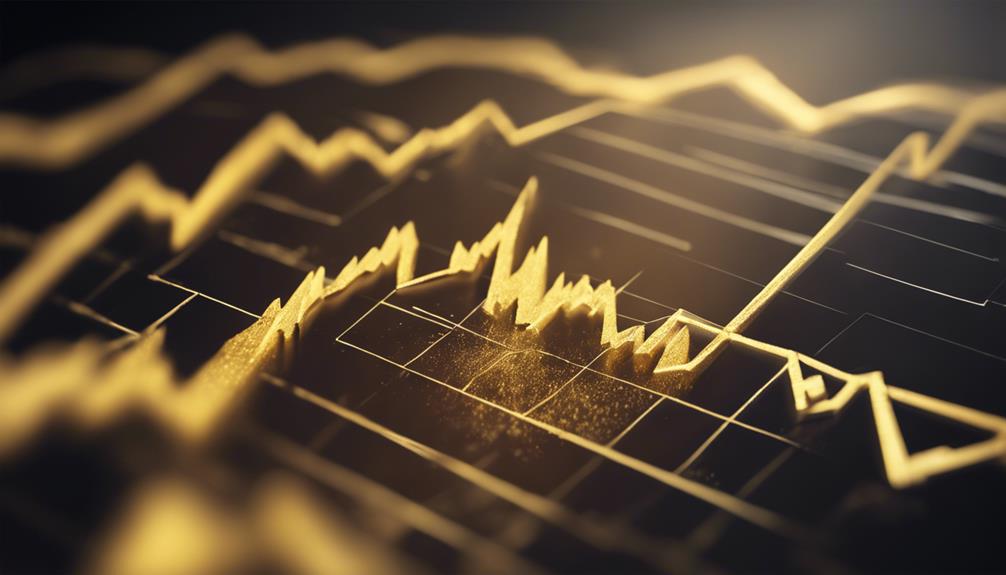
Highlighted by its enduring nature and unique supply dynamics, factors influencing gold prices extend beyond traditional commodity consumption patterns.
The gold market stands out due to its distinctive characteristics, such as the significant role central banks play in influencing prices during periods of economic growth or stability. Additionally, gold's supply factors, including mining output and recycling rates, can have a substantial impact on market dynamics and price levels.
The enduring nature of gold, with most mined gold still in existence, contrasts with the consumption-driven trends of other commodities. Additionally, jewelry demand serves as an important factor in the gold market, affecting prices based on consumer preferences and trends.
Understanding these supply dynamics is essential for investors and stakeholders looking to navigate the complexities of the gold market and make informed decisions regarding gold prices and investments.
Interest Rates Impact

Interest rates wield a significant influence on gold prices, as seen in the market's reactions to Fed rate adjustments.
Inflation trends and Federal Reserve decisions also play pivotal roles in shaping the relationship between interest rates and gold values.
The intricate interplay between rate hikes, inflation dynamics, and central bank policies underscores the complexities of gold price movements in response to interest rate fluctuations.
Rate Hikes Affect Gold
When central banks raise interest rates, the attractiveness of non-interest-bearing assets like gold diminishes among investors. This phenomenon occurs due to the increased opportunity cost of holding gold compared to interest-bearing investments.
The Federal Reserve's decisions on interest rates play a pivotal role in shaping the trajectory of gold prices, with hikes leading to downward pressure on gold prices. Changes in interest rates not only affect gold prices but also signal shifts in economic conditions, influencing investor sentiment towards gold.
Investors closely monitor central banks' actions, particularly the Federal Reserve, as they assess the impact of interest rate changes on the gold market.
- Increased opportunity cost of holding gold
- Federal Reserve's pivotal role in shaping gold price trajectory
- Influence of interest rate changes on investor sentiment
Inflation Drives Gold
Factors influencing gold prices extend beyond interest rate hikes. This is demonstrated by the intricate connection between inflation and the dynamics of the gold market. Despite common belief, gold prices do not always align closely with inflation rates. For instance, in 2022, a 7% inflation rate coincided with a decline in gold prices, showcasing the complex relationship between these factors.
Economists Erb and Harvey have identified a weak correlation between gold prices and inflation, indicating that other variables also play a significant role. While interest rates impact gold prices inversely, with prices tending to rise during Fed rate cuts, central banks' actions during economic growth phases can also influence the gold market.
This intricate interplay highlights the multifaceted nature of factors driving gold prices.
Federal Reserve Decisions
Federal Reserve decisions wield significant influence over the direction of gold prices, particularly through their management of interest rates. The Federal Reserve's actions on interest rates can have a direct impact on the value of gold, with changes often leading to corresponding movements in gold prices.
Investors closely watch the Federal Reserve's statements and decisions regarding interest rates as these can signal potential shifts in the market, prompting adjustments to their investment strategies.
Central banks' policies regarding interest rates play an essential role in shaping the overall economic landscape, and their decisions can create ripples that reach the gold market, affecting both short-term fluctuations and long-term trends.
Central Bank Policies
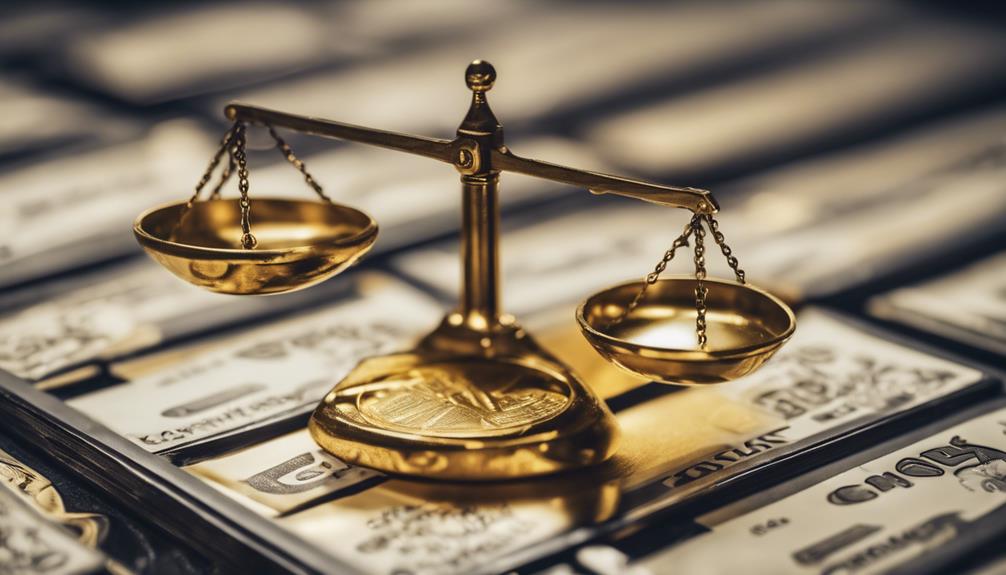
Central bank policies play a vital role in influencing gold prices, particularly through decisions on interest rates and quantitative easing measures. Changes in central bank strategies can impact the demand and supply dynamics of gold, leading to fluctuations in its market value.
As central banks consider gold a reserve asset, their actions can have a significant effect on the overall dynamics of the precious metal market.
Interest Rate Impact
The impact of interest rates on gold prices is an essential aspect influenced by central bank policies. When the Federal Reserve implements rate cuts, gold prices typically rise, demonstrating the direct correlation between interest rates and gold values.
Central banks hold substantial power in influencing gold prices through their monetary policy decisions, which can create fluctuations in the market. The sensitivity of gold to central bank actions was evident when gold prices fell following indications of potential interest rate hikes by the Fed.
Additionally, during periods of economic growth, central banks may reduce their gold holdings, thereby affecting the supply and demand dynamics of this precious metal.
Quantitative Easing Effects
Following the shifts in interest rates, the impact of quantitative easing by central banks on gold prices is a complex interplay of market dynamics and investor behaviors. Quantitative easing, a policy where central banks purchase financial assets to stimulate economic growth, can have mixed effects on gold prices.
While it may trigger inflation fears, it can also boost risk appetite in markets. During periods of quantitative easing, gold prices exhibit both positive and negative reactions, influenced by various market factors. Central bank policies such as quantitative easing indirectly affect gold prices through changes in investor sentiment and market confidence.
The uncertainty created by quantitative easing measures often leads investors to view gold as a safe haven asset, potentially supporting its prices amidst market volatility.
Geopolitical Influences

Amidst the intricate landscape of global economics, geopolitical tensions wield a profound influence on the fluctuation of gold prices, serving as a pivotal factor in shaping market dynamics.
Geopolitical tensions, such as trade disputes and diplomatic tensions, can greatly impact the price of gold by increasing its demand as a safe haven asset during times of uncertainty. Additionally, political instability around the world often leads investors to seek refuge in gold, driving up its prices due to heightened risk perception.
Furthermore, global events like natural disasters and geopolitical conflicts have the potential to cause spikes in gold prices, as they can sway market sentiment and increase the attractiveness of gold as a stable investment option for investors seeking security amidst turmoil.
These factors highlight the essential role that geopolitical influences play in the gold market, showcasing how events on the world stage can reverberate through financial markets, ultimately affecting the value of this precious metal. This interconnectedness underscores how investor sentiment and risk perception often shift during times of geopolitical uncertainty, driving demand for gold and other safe-haven assets. The value of precious metals is particularly sensitive to such dynamics, as they are considered reliable stores of wealth during periods of economic instability. Consequently, fluctuations in the value of precious metals can serve as a broader indicator of global market sentiment and economic outlook.
US Dollar Strength
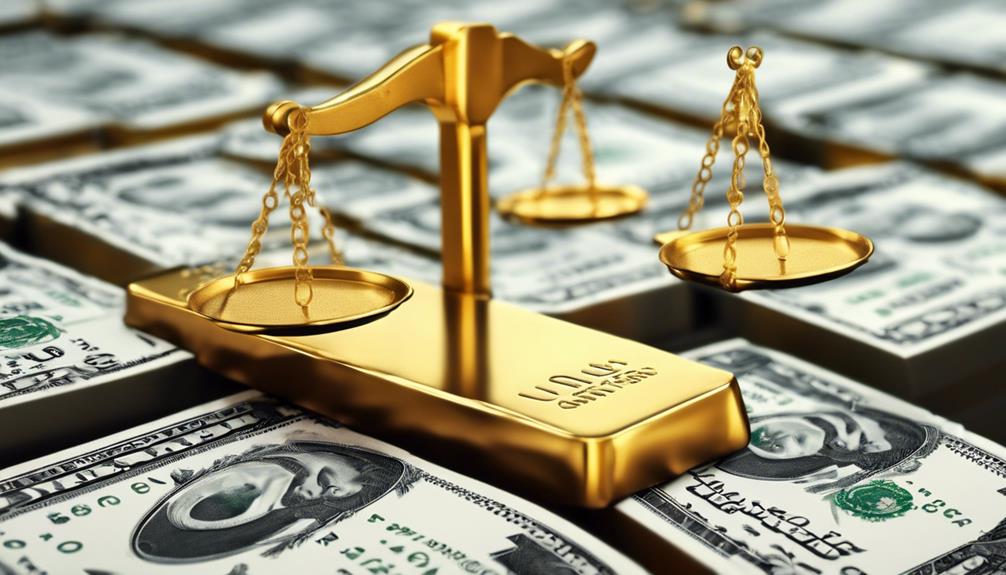
Influence of the US dollar's strength on gold prices is significant in global financial markets. When the US dollar strengthens, gold prices tend to decrease, and conversely, a weaker dollar often leads to higher gold prices. This relationship is important as changes in the US dollar index directly affect the purchasing power of gold in international markets. Investors closely watch the US dollar's strength as it is a key factor influencing short-term fluctuations in gold prices and market sentiment. Additionally, US dollar movements can impact demand for gold as a safe-haven asset. Understanding the interplay between the US dollar and gold prices is essential for investors looking to buy or sell gold based on market trends.
| Factors Influencing Gold Prices | ||
|---|---|---|
| US Dollar Strength | Gold Prices Rise | Exchange Rate Impact |
| Strengthening Dollar lowers gold prices | Increased demand for gold | Direct impact on purchasing power |
Investment Demand
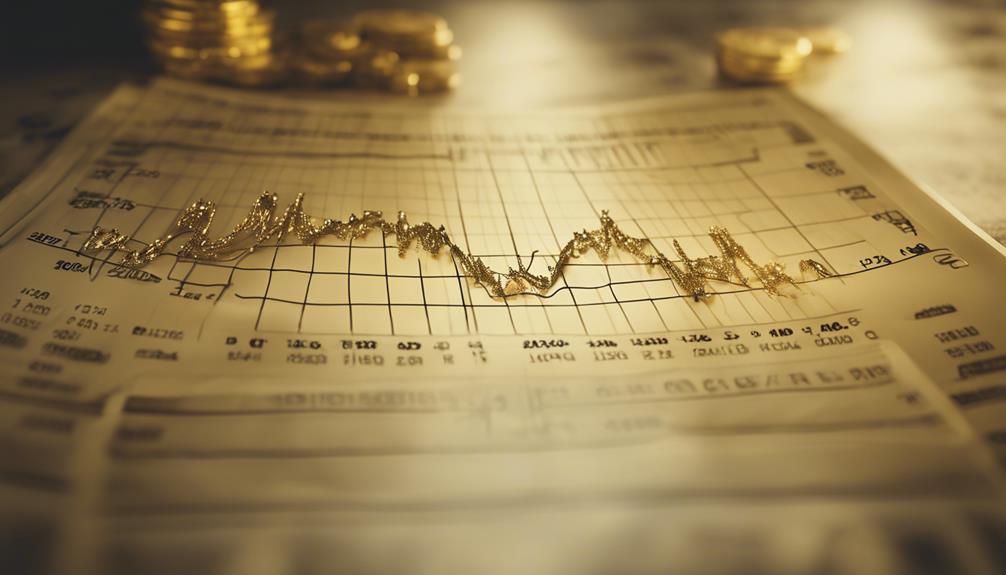
Investment demand for gold is an essential factor influenced by economic and market conditions. When contemplating factors influencing gold prices, it is vital to grasp the dynamics of investment demand. Here are key points to ponder:
- Gold is often sought as a safe haven during market volatility and uncertainty, driving up investment demand.
- Rising interest rates can impact investment demand for gold as it becomes less attractive compared to interest-bearing assets.
- Global investment shifts, including the growing popularity of digital assets like Bitcoin, may influence investor preferences towards gold as a tangible asset with intrinsic value.
These factors highlight the intricate relationship between investment demand and gold prices. Investors closely monitor economic conditions and market trends to gauge the strength of investment demand for gold, ultimately impacting its value in the market.
Cultural Preferences

Cultural preferences play a significant role in shaping the demand for gold across various regions, reflecting the crucial significance of this precious metal in societal traditions and practices.
In countries like India, gold jewelry holds immense cultural significance, especially during festivals and weddings, driving high demand for this precious metal. Similarly, China's cultural affinity for gold as a symbol of wealth and prosperity contributes substantially to the global demand for gold. Many societies view gold ownership as a store of value and a status symbol, further boosting its desirability.
Additionally, gold plays an essential role in religious ceremonies across different cultures, where it is exchanged or gifted, elevating its demand and cultural importance. This deep-rooted cultural significance of gold influences consumer behavior and market dynamics in the gold industry, highlighting the intricate relationship between cultural preferences and the demand for gold.
Market Sentiment
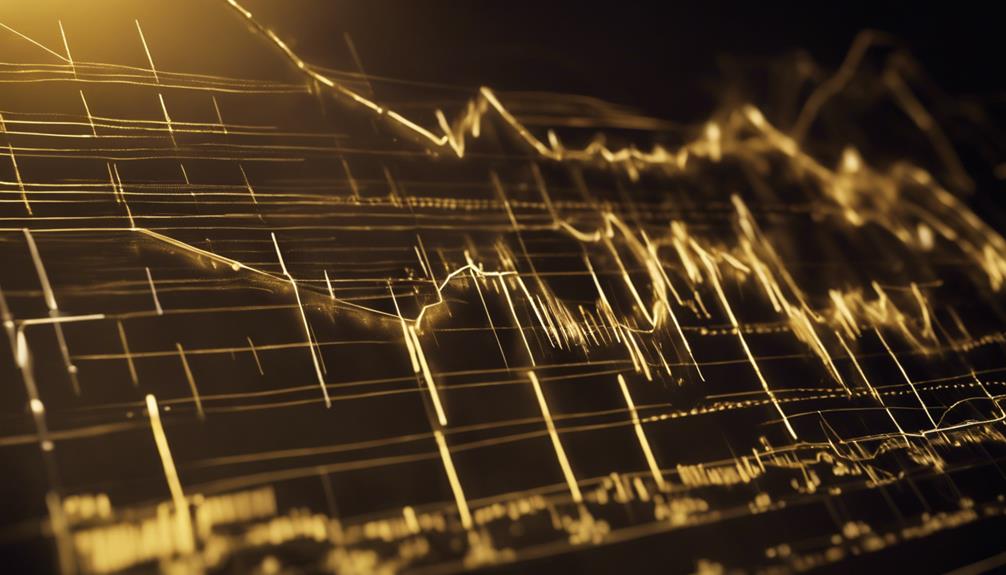
Market sentiment serves as a pivotal factor in driving short-term fluctuations in gold prices, influenced by speculative trading, economic uncertainties, and risk aversion. In the domain of gold trading, emotions can often override rational decision-making processes, leading to rapid changes in price. This sentiment-driven market behavior can result in erratic movements that are not always in line with fundamental factors.
- Speculative trading: Traders often make decisions based on market sentiment rather than concrete data, leading to exaggerated price swings.
- Economic downturn: Fear of economic instability can drive investors towards safe-haven assets like gold, causing sudden spikes in demand.
- Risk aversion: During times of uncertainty, investors tend to seek refuge in gold due to its historical reputation as a store of value.
Media coverage and investor sentiment also play significant roles in shaping gold price trends, further contributing to the volatile nature of gold prices. Trend-chasing behavior can exacerbate short-term price movements, making it essential for traders to closely monitor market sentiment to navigate these fluctuations effectively.
Frequently Asked Questions
What Factors Influence the Price of Gold?
Various factors influence the price of gold, including global economic conditions, central bank policies, inflation rates, geopolitical events, and supply-demand dynamics.
Additionally, the value of the U.S. dollar, exchange rates, and interest rates play pivotal roles in determining gold prices.
Gold's status as a safe haven asset during economic uncertainty and geopolitical instability also impacts its value.
These diverse elements collectively shape the fluctuations seen in the price of gold.
How Is Gold Price Influenced?
The price of gold is influenced by a multitude of factors that encompass global economic conditions, central bank policies, inflation rates, geopolitical events, and supply-demand dynamics.
Factors such as the value of the U.S. dollar, exchange rates, interest rates, and geopolitical tensions play vital roles in shaping gold prices.
Additionally, demand for gold, driven by industrial and investment purposes, is impacted by economic growth in key markets like China and India.
What Makes the Value of Gold Go up and Down?
The value of gold fluctuates due to a multitude of factors, including economic stability, global events, supply and demand dynamics, and market sentiment.
Economic uncertainty, geopolitical tensions, and inflation concerns can drive gold prices up, while a strong U.S. dollar and stable economic conditions may lead to a decrease.
Understanding these various influences helps investors navigate the complexities of the gold market and make informed decisions. Understanding these various influences helps investors navigate the complexities of the gold market and make informed decisions. For example, geopolitical tensions, currency fluctuations, and inflation fears often drive interest in gold as a safe-haven asset. If you’re considering diversifying your retirement portfolio, options like rolling your 401k into gold can provide a hedge against economic uncertainty while preserving wealth over the long term. Staying informed about market dynamics enables investors to maximize the potential benefits of gold investments.
What Causes the Price of Gold to Drop?
A decline in gold prices can be attributed to various factors such as a strengthening U.S. dollar, interest rate hikes by central banks, economic stability, reduced geopolitical tensions, and increased gold supply exceeding demand.
These elements collectively contribute to a decrease in the price of gold as market dynamics shift. Understanding these influencers is essential for investors and stakeholders in the gold market to make informed decisions based on market trends and developments.
Conclusion
To sum up, various factors influence gold prices, such as:
- Inflation
- Supply
- Interest rates
- Central bank policies
- Geopolitical influences
- US dollar strength
- Investment demand
- Cultural preferences
Market sentiment also plays a significant role in determining the value of gold. As the saying goes, 'all that glitters is not gold,' and understanding these factors can help investors make informed decisions when it comes to gold investments.

